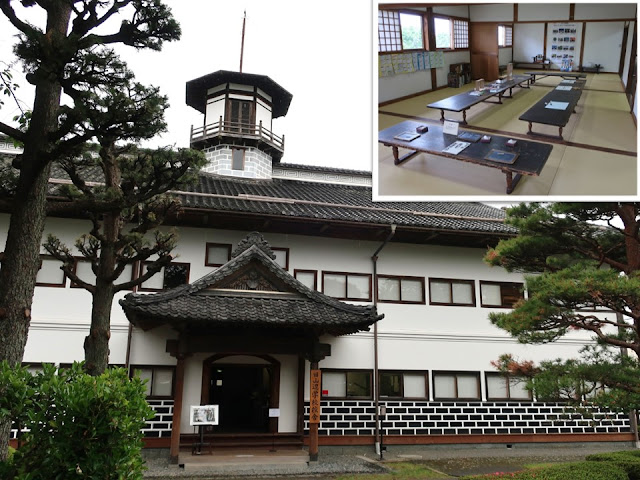Author : Miyamoto Tsuneichi(1907-1981)、著者:宮本常一
Fun of studying、知る楽しみ
・Interviewees with
literacy、文字をもつ伝承者(一)
The
interview to Mr. Moriwaki is very impressive. He didn’t graduate a college, but
passed the national examination and became an elementary school teacher. He was
a historian, too. He completed a thousand-page book of his village history and
folklore.
The
author, who was a prominent folklorist, wrote that Mr. Moriwaki wasn’t an
ambitious person at all. He just enjoyed absorbing in the research. He
invited a college teacher from the prefectural capital at his own expense, and
got advice. He also tried to become a postman, because he was deeply interested
in place names and family names. He knew the fun of studying. He lived in a
mountainous area in Shimane Prefecture of western Japan.
独学で小学校の先生の検定試験に受かって教員をしていた森脇太一氏の学びの意欲は感動物です。氏が住む島根県の山間部に、自費で島根師範から先生を招いて、実地指導を受け、「邑智郡誌」(1000ページ)をまとめました。
「この人はちっとも野心家ではない。そういう事に精力をつかうのがたのしいのである」と書かれています。地名と家名に興味を持っていたので、郵便配達をしようと思ったほどの人です。知の楽しみを知る人です。
・The other interviewees
with literacy、文字をもつ伝承者(二)
Mr.
Takagi was a farmer and liked walking; he stopped by any shrine or temple
and talked with the local farmers. He said, it was the most fun thing for him.
He was an excellent researcher and posted a paper to an academic journal.
However, he was reluctant to be famous, and he didn’t write a book even though
Dr. Miyamoto (author) recommended it. He liked finding new things. He lived in
Taira City in Fukushima Prefecture of north-eastern Japan. It's a preferable
lifestyle for me.
福島県平市の農家・高木誠一氏は、歩くのが好きで、お宮、お寺があれば必ず参り、百姓たちと話をしました。「そういうことが何よりもたのしみだという」のです。たいへん碩学な方で、学会誌に投稿もしていますが、目立とうとせず、著者に勧められても本は書きませんでした。知ること自体が楽しみなのですね。
Appendix: a village community、番外:人付き合い
- In Tsushima Island of western Japan,
it took long time when they decided something concerning their village. They
discussed until all villagers were satisfied; they checked past cases and
talked. It was not a majority rule; it spent time and strengthened villagers’
tie, I think.
- There was a knowledgeable and
helpful person in each village. It was a role of a retiree. They gave a
hand to a person in need and solved the issue in private, which was also
the matter of a village. The bond among residents became weaker, and such
person is rare now.
In the chapter of the looking for a
lost child, it is written how the residents cooperate effectively. It’s a good
community.
・対馬では、村の事はみんなが納得するまで何日でも話し合いました。過去の事例を出し合い、話し合うのです。多数決ではなくて、時間をかけて合意形成ですね。(対馬にて)
・村の中のことを何でもかんでも知っている世話焼きがいました。隠居の仕事です。人の気づかぬところで困っている人の相談に乗り、村のひずみを直しました。町内では、つながりが薄くなり、そういう人は減りました。民生委員ですね。(村の寄りあい)
「子供をさがす」の項では、近所の助け合いが、極めて有効に働いている様子が描かれています。強いコミュニティです。
Japanese
rice planters at dinner-eating rice (1905)、農作業の賄いhttps://www.loc.gov/item/2020637910/
The author found two good ways
during a mundane life in a small village.
The first one is to burst and release
energy as through gatherings: festivals, or feasts such as a passage rite of your
child.
The second way is to find a personal
fun thing in which you can fulfill your wish. As examples, we wrote a battle
between a mother-in-law and a wife, a theft and a male-female relationship.
One is a wholesome way to relieve
stress, and another is unwholesome way to do so. Do you agree?
・著者は、狭い村の単調な生活の救いになることとして、次の二つを挙げています。
①集まりによって「人間のエネルギーを爆発させること」。具体的には、祭りと子供の通過儀礼など家々の招宴です。
②「私生活の中で自分の願望を果たせる世界を見つけること」で、人に見せられぬ個人の行為です。嫁姑関係(姑の嫁いじめ、嫁の姑いじめ)、窃盗、男女関係を例としています。
健全なストレス発散と不健全な発散です。どう思いますか?(村の寄りあい)
Dr. Miyamoto (author) was an excellent
interviewer especially with elderly people. He got information of the
lifestyle mainly in the Meiji period (1868-1912) one after another. Every
interview written in this book is concrete and dynamic. I highlighted the fun
things during life. Even their living standard was low, everyone had fun. Some of them were already lost such as singing a folk song while working
or living. The lovemaking was freer than today, I think.
“The
Forgotten Japanese” is a nice title because many things, which we had better know, are written. Dr. Miyamoto (1907-1981) questioned “What is the progress?”, “What is the
development?” very late in his life. He clearly mentioned that we have thrown
away too many things in order to progress and develop. Although I just
highlighted the fun things in life, our holistic lifestyle which was lost is
written. I recommend; you can buy it on Amazon (Amazon | The Forgotten Japanese:
Encounters with Rural Life and Folklore | Miyamoto, Tsuneichi, Irish, Jeffrey |
Ethnic Studies)
A street performer, Kobe, Japan (1896)、猿回し? https://www.loc.gov/item/2020684961/
宮本常一は、古老の話を聞くのが上手で、明治時代を中心とした人々の生き様を引き出しています。どなたの話も事実ならではの迫力がありました。その中から、人々の楽しみについて抽出しました。生活水準が低くても、皆さん、楽しみを持っていました。仕事や日々の生活の中にあった歌は、今では無くなってしまいました。また、性の楽しみは今よりもおおらかだったと思います。
「忘れられた日本人」は、よいタイトルで、この本には我々が学ぶべきことがたくさん書かれています。宮本(1907-1981)は最晩年に、進歩とは何か、発展とは何か、それらの名のもとに、「われわれはじつにたくさんのものを切り捨ててきたではないか」とはっきり言っていたそうです〔1〕。私は、人々の楽しみしか取り上げませんでしたが、本書には、今は失われた生き方が書かれています。お薦めの書です。
参考文献〔1〕網野善彦(2003):『忘れられた日本人』を読む
Previous post (Part5 of this article, Lovemaking、男女間の楽しみ): The Forgotten Japanese (published in 1960 )(5/6)、忘れられた日本人 part5
Next post (History and fun things about eating、食べる歴史と楽しみ): Old dietary habit in Japan (published in 1968)、食生活の歴史



Comments
Post a Comment